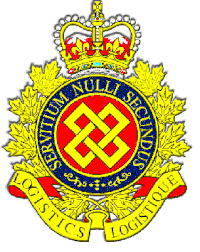Royal Canadian Logistics Service
The Royal Canadian Logistics Service (RCLS, French: Service royal de la logistique du Canada) is a personnel branch of the Canadian Armed Forces (CAF).
| Royal Canadian Logistics Service | |
|---|---|
| Service royal de la logistique du Canada (French) | |
 | |
| Active | 1968–present |
| Country | |
| Branch | |
| Type | Military logistics |
| Role | Supply chain management, transportation, human resource management, finance, food services, postal and ammunition |
| Home Station | CFB Borden |
| Motto(s) | Latin: servitium nulli secundus, lit. 'Service Second to None' |
| March | "March of the Logistics Branch" |
| Anniversaries | 1 February 1968 |
| Commanders | |
| Colonel of the Regiment | HM Queen Elizabeth II |
In April 1997, the CF Armed Forces Council decided to incorporate the Personnel Administration Branch into the Logistics Branch.
From 1968 to 2018 the organization was named the Logistics Branch. On October 16, 2018, on the occasion on its 50th anniversary, the Logistics Branch received its "Royal" designation from Queen Elizabeth II becoming the Royal Canadian Logistics Service.[1]
Unification
When the Canadian Army, Royal Canadian Navy, and Royal Canadian Air Force were merged in 1968 to form the Canadian Forces, the administrative corps of the Canadian Army were deactivated and merged with their naval and air force counterparts to ultimately form the Canadian Forces' Logistics Branch.
- The Royal Canadian Army Service Corps transport and supply elements were combined with the Royal Canadian Ordnance Corps to form the Logistics Branch
- The Royal Canadian Postal Corps, and Royal Canadian Army Service Corps clerical trades, were merged to form the Administration Branch (later merged with the Logistics Branch)
Training
Canadian Forces Logistics Training Centre
Canadian Forces Logistics Training Centre (CFLTC) (formerly known as Canadian Forces School of Administration and Logistics or CFSAL) has an establishment of 181 military and 14 civilian personnel and is organized into a headquarters and three divisions:[2]
- Supply and Food Service Training Division;
- Financial and Human Resources Training Division;
- Transportation and Traffic Training Division;
- Postal Training Cadre (CFB Trenton);
- Music Training Division;
- Explosives Training Division; and
- Logistics Leadership Division, which oversees Officer and Advanced Training.
Each year, CFLTC trains approximately 3,000 military members (both Regular and Reserve Force) and civilians. CFLTC provides entry-level training to logistics officers from all three environments. In addition, CFLTC trains the following sub-occupations for logistics officers: supply chain management, financial management, human resources management, fleet management and food services.
CFLTC trains the following occupations for non-commissioned members: human resources administrator, financial service administrator, cook, supply technician, ammunition technician, traffic technician, mobile support equipment operator, and musician.
Order of precedence
| Preceded by Air Operations Branch |
Royal Canadian Logistics Service | Succeeded by Royal Canadian Medical Service |
References
- "Governor General to Attend the Royal Canadian Logistics Service 50th Anniversary Parade". Governor General of Canada. October 15, 2018. Retrieved October 17, 2018.
- "Canadian Forces Logistics Training Centre (CFLTC)". Borden.forces.gc.ca. 2012-02-08. Archived from the original on 2013-01-21. Retrieved 2013-01-10.